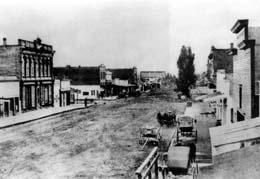On June 11, 1878, Washington Territory legislators meet in Walla Walla to craft a state constitution. Walla Walla is the largest city in the territory in 1878 and the most logical place for politicians to meet. Legislators arrive in June and complete the constitution in 40 days. The constitution they draft will be ratified at the next general election in November, but later rejected by Congress.
Legislators had contemplated statehood for at least 10 years before they finally met in Walla Walla. The general citizenry was less enthusiastic. The voters were happy to let Congress pay the cost of government; after becoming a state, this cost would become the burden of state residents. It wasn’t until 1875 that residents finally approved a bill to create a constitution. About 7,000 men (women did not yet have the vote) voted on the resolution.
On April 9, 1878, voters elected the delegates who would craft the constitution. The following delegates represented the territorial counties:
- W. A. George, Walla Walla County;
- Edward Eldridge, Whatcom County;
- S. M. Gilmore, Klickitat County;
- S. M. Wait, Columbia County;
- B. F. Dennison, Second Judicial District;
- C. H. Larrabee, Third Judicial District;
- C. M. Bradshaw, Jefferson County;
- Henry B. Emery, Kitsap County;
- L. B. Andrews, King County;
- D. B. Hanna, Pierce County;
- Frank Henry, Thurston County;
- A. S. Abernethy, Cowlitz County;
- G. H. Steward, Clark County;
- O. P. Lacy, Walla Walla County;
- J. V. O'Dell, Whitman County.
Alonzo Leland represented Nez Perce County, Idaho, but did not have a vote.
In early June, the delegates arrived in Walla Walla, the largest city in the territory, to hold a constitutional convention. The Idaho gold rush had created a boom in Walla Walla, the nearest supply post. Completion of the Walla Walla & Columbia River Railroad in 1875 ensured continued growth of the community. The delegates stayed at the nearby Stine House, two blocks from the meeting place.
On June 11, the delegates met for the first time at Science Hall, on the second floor of the Reynolds-Day Building. The constitutional convention began with a briefing, chaired by W. A. George, held before the convention proper. The main order of business was to select officers to chair the convention. Delegates chose A. S. Abernethy as president of the convention, W. B. Daniels as clerk, W. S. Clark as Daniels's assistant, and Walla Walla law students A. P. Sharpstein and J. W. Norris as pages. They elected Henry D. Cook as sergeant-at-arms.
The formal convention began the next day. Meetings began at 9 a.m. and generally lasted until 5 p.m. Smaller groups sometimes met during the evenings. This continued for 40 days. The Walla Walla Union published the proceedings of the convention.
The delegates discussed several ordinary measures for inclusion in the constitution. These included qualifications for voting, a uniform system of taxation, earmarking money for educational purposes, and establishing courts. They set legislative sessions at 40 days and gave the legislature the power to change the seat of government. They established provisions for penal institutions.
One of the most controversial issues discussed was woman suffrage. This issue came up on the third day of the convention and by the sixth day, B. F. Dennison presented a petition signed by 600 men and women asking that the matter be addressed. G. H. Steward requested that woman suffrage leader Abigail Scott Duniway be permitted to address the convention. Duniway spoke for a half hour, appealing to the delegates to make Washington the first state to grant women the right to vote. Some progress was made when the delegation voted to give married women the right to enter into a contract and to pursue legal action against any wrongdoer.
The delegates took a break to celebrate Independence Day, but worked hard the next day to make up for lost time. They spent July 5 crafting an article that described impeachment procedures for state officials. The next day they discussed jury trials and imprisonment of debtors. Territorial Governor Elisha P. Ferry (1825-1895) was present for these arguments.
Other issues discussed by the delegates included establishing separate schools for black children and abolishing the Indian reservation system. The delegates voted against these proposals. The delegation also fixed the border of the eastern boundary of the new state, which included the productive mining districts of the northern panhandle of Idaho. The issues of temperance and woman suffrage were left to be voted upon separately.
At the end of the convention, the delegates took a combination rail and steamer excursion to Lewiston, Idaho. They left for the first leg of the journey on Saturday, July 27. They rode the Walla Walla & Columbia River Railroad to Wallula and arrived by 4 p.m. They boarded the steamer Almota the next morning at 3 a.m. They arrived at Lewiston the following evening at 5 p.m. After an evening of entertainment, the delegates left for Walla Walla Tuesday morning. After 40 days, the delegates had designed a constitution for the new state, which was still unnamed.
In November, voters ratified the constitution in the general election. Territorial voters approved the measure 6,462 to 3,231. In Congress, the enabling bill died in committee. Historian Dorothy Johansen speculates that the reasons for failure were two fold: the desire of many Walla Walla and Portland residents to be part of Oregon, which would bring relief from the "death embrace with Puget Sound" (Johansen, 337) and Democrats' concern over admission of a Republican-leaning state. It would be 11 more years before Washington became a state in 1889. At that time voters rejected both prohibition and woman suffrage.

